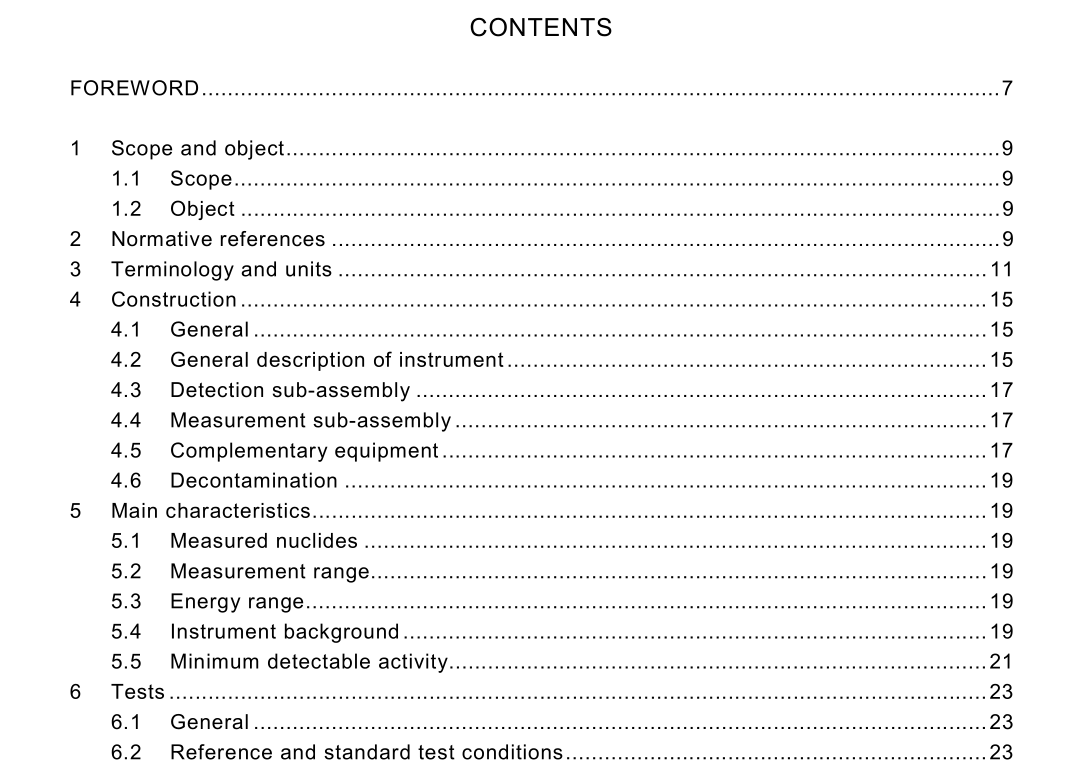IEC 61563 pdf download

IEC 61563 pdf download.Radiation protection instrumentation – Equipment for measuring specific activity of gamma-emitting radionuclides in foodstuffs
1 Scope and object
1.1 Scope This International Standard applies to portable instruments used for measuring the specific or volumic activity of gamma-emitting radionuclides in food/foodstuffs intended for operation under field conditions, particularly in case of a post-accidental situation. It does not apply to low background laboratory instrumentation requiring highly skilled personnel. The instruments designed for measurement of gamma contamination in foodstuffs under field conditions should not require special sample preparation other than machining (cutting, grinding, etc.). These instruments may be used, in principle, to measure the gamma emitting surface contamination and other radiation measurements as well, but these applications are outside the scope of this standard. The same instruments intended for measuring foodstuffs can also be used for the measurement of environmental samples, such as soil, sewage, plant and animal life, etc. These instruments can be used to estimate specific gamma activity for a wide variety of samples according to this standard.1.2 Object The purpose of this standard is to specify the main performance characteristics of instruments, intended for measurement of specific activity of gamma-emitting radionuclides in foodstuffs, their methods of testing and documentation requirements.
3 Terminology and units
The general terminology for detection and measurement of ionizing radiation and nuclear instrumentation is given in IEC 60050(393) and IEC 60050(394). For the purpose of this standard the following definitions apply: 3.1 radiation meter instrument intended to measure quantities related to ionizing radiation [IEV 394-02-01 ] 3.2 specific activity activity per unit mass (Bq/kg) [IEV 393-04-1 3 modified] 3.3 volume activity activity per unit volume (Bq/m 3 ) [IEV 393-04-1 4 modified] 3.4 detector efficiency ratio of the number of detected particles to the number of particles of the same type which are incident on the detector in the same time interval [IEV 394-1 8-21 ] 3.5 response time time required after a step variation in the measured quantity for the output signal value to reach for the first time a given percentage, usually 90 %, of its final value [IEV 394-1 9-09 modified] 3.6 surface emission rate (of a source) number of particles of a given type above a given energy emerging from the face of the source or its window per unit time [IEV 393-04-92] 3.7 concomitant ionizing radiation ionizing radiation that accompanies the measured radiation but is not an object of measurement and whose influence on the results should be reduced as much as possible For gamma-radiation meters measuring under field conditions, beta-radiation is a concomitant radiation. [IEV 393-02-22 modified] 3.8 sensitivity (of a measuring assembly) for a given value of the measured quantity, ratio of the variation of the observed variable to the corresponding variation of the measured quantity [IEV 394-1 9-07] 3.9 effective range of measurement range of values of the quantity to be measured over which the performance of a piece of equipment or assembly meets the requirements of its specifications [IEV 394-20-1 6] 3.1 0 conventionally true value of a quantity best estimate of the value of the quantity used for a given purpose NOTE A conventionally true value is, in general, regarded as sufficiently close to the true value for the difference to be insignificant for the given purpose. For example, a value determined from a primary or secondary standard or by a reference instrument, may be taken as the conventionally true value. [IEV 394-20-1 0]
4 Construction
4.1 General The following radiation meter types are used for specific activity measurements under field conditions: a) Radiation meters allowing measurements in approximately 2π geometry. Radiation meters with plane window detectors refer to this type. They permit measurement of surface contamination as well. b) Radiation meters for liquid and loose solid samples allowing measurement in approximately 4π geometry, containing detectors with enveloped surfaces. Liquid sources are poured into a detector cell and may be in close contact with the detector. Loose solid samples may have protective covers, packages, cuvettes, etc. In this type of detectors, measuring geometry and sample volume are fixed.









